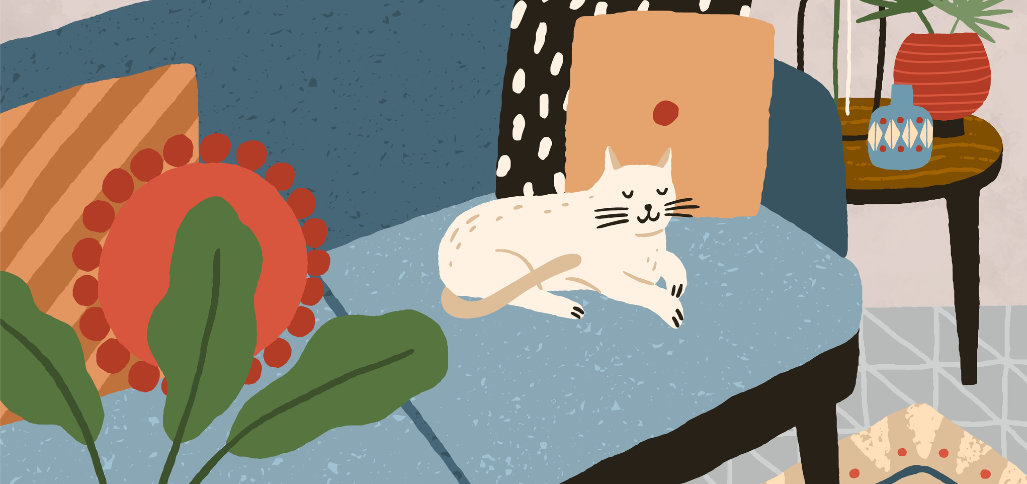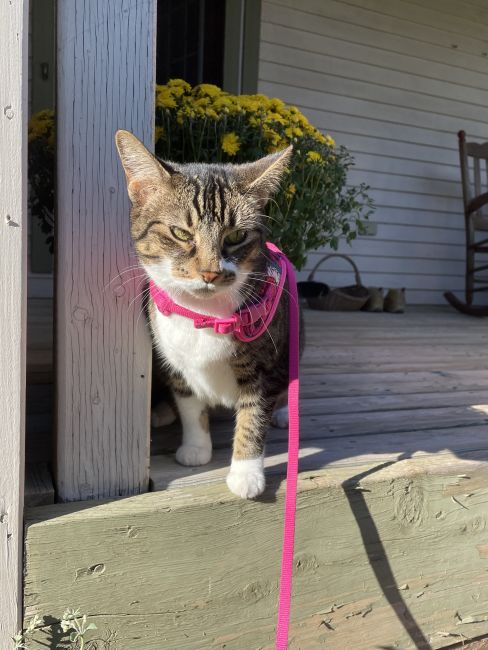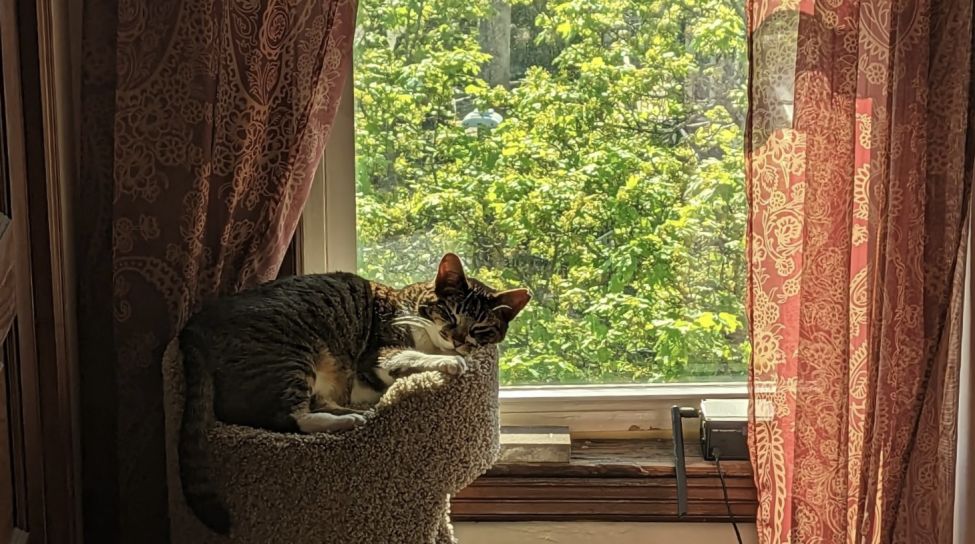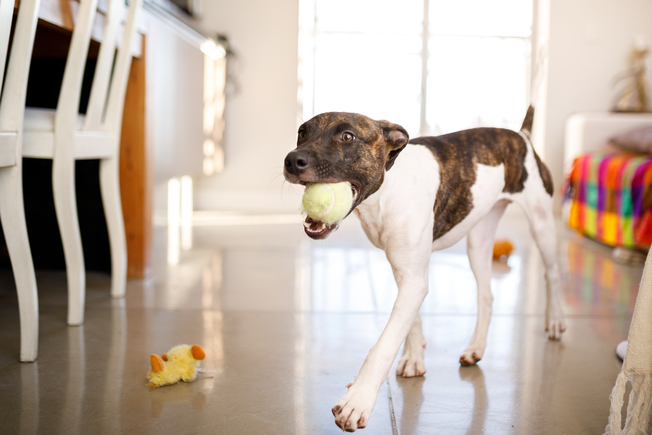
How to Cat-Proof Your Apartment

By Lilly Milman
May 26, 2023
Cats can be mischievous and — if you don’t cat-proof your apartment — can make a mess of your home quickly. From scratching up furniture to chewing on plants to knocking things over, cats can be a handful. While much of this is normal behavior for a cat, it can be frustrating as an owner to keep cleaning up after your pet. Plus, if you unknowingly have a reachable plant that’s poisonous to cats, it can even be dangerous.
A lot of this behavior can be mitigated by making a few changes at home — like adding scratching posts or carving out more time during the day for playing with and mentally engaging your cat.
We spoke to a few cat experts to learn about what you can do to cat-proof your apartment to keep your apartment clean, your cat out of trouble, and your sanity intact when you get a new pet.
How do I make my cat stop scratching furniture?
Unfortunately, it’s completely normal and common for your cat to want to scratch your furniture, rug, or curtains. This is how cats sharpen their nails and mark their territory in your home. One way to deter your cat from scratching your furniture, give them something else to claw at instead.
“Cats need scratching posts throughout the house, ideally at exits and entries,” says Doron Wolffberg, founder of Cats.com. “It’s recommended to use a mixture of vertical and horizontal scratching posts. The vertical posts should be tall enough so that your cat can just about reach the top with their paws when they stretch.”

While it’s difficult to discourage a cat from scratching furniture, it’s possible to encourage them to scratch a scratching post or play with a toy instead, says veterinarian Dr. Alejandro Caos, who works with the mobile pet care company The Vets.
“You want to redirect the unwanted behavior to wanted behavior — and that includes with treats,” Dr. Caos says. “Even though we don't tend to think of cats as being as trainable as dogs, they are. You just have to have a different approach.”
There are also semi-permanent furniture protectors you can install — and if all else fails, just try to keep the cat out of the room with the furniture you want to keep safe, Caos says.
How do I give my cat enough exercise in an apartment?
It’s up to you to make sure your cat is stimulated and gets enough exercise every day — similar to if you had a dog. They may not want to go on a traditional walk or play fetch like a dog, but they still need toys and other forms of enrichment.
“We tend to look at a cat as these individuals on their own, not like a dog,” Caos says, but this is a misconception.
Motorized cat toys, which can move around on their own and keep your cat engaged even when you’re not at home, are one option. Another is creating a sort of “scavenger hunt” for your cat, which Caos did for his own cat in the past.
“I put shelves up in a spare room with cat hammocks and areas to hide and explore, and sometimes tucked away [dry] cat food in this play area,” he explains. “What that does is that gives the cat something to look forward to. They start hunting or scavenging for that food and that's a good way to keep their minds and bodies busy.”
Some people even do walk their cats using a tight harness, which requires some training.

What plants are poisonous for cats?
Cats are notorious for their curiosity — and that often extends to chewing on plants, which may be poisonous. Lilies, tulips, rhododendrons, chrysanthemums, pathos, and philodendron plants are some of the most common poisonous plants that Caos treats cats for after they have ingested them. Cannabis is also toxic to cats if ingested.
If you suspect that your cat has ingested a toxic plant, then first take note of how long it’s been since they’ve eaten it, Caos says. Then, go to the nearest emergency vet. If you’re able to, Caos recommends bringing a photo of the plant or a clipping of it. You can also call the ASPCA poison control hotline for assistance
How do I make my cat stop chewing on plants?
Some cats tend to chew on any plant in the vicinity, while others don’t show much interest. You can’t really control which of these types your cat is. Your only option to ensure that your furry friend doesn’t chew on a plant is to prevent your cat from having access to the plant. So, keep it in a closed room — especially if it’s toxic. Better yet, don’t keep any toxic plants in the home at all.
“There are plenty of beautiful houseplants and flowers that you can have in the home that will not be detrimental to your cat's health,” Caos says.
How do I make my apartment safe for cats?
Cat-proofing your home is a lot like baby-proofing — even if you are bringing home an adult cat. After you’ve removed toxic plants, there’s still a few steps you can take to ensure your pet is safe. Start by storing anything a curious cat may swallow, like loose wires or electrical cords, advises Heather Byron, a manager at the adoption facility A New Leash on Life in Huntsville, AL.
“Use double-sided tape or aluminum foil on surfaces you don't want them to jump on — cats despise these textures,” she says. “For window safety, ensure screens are sturdy and keep windows that aren't screened shut. Lastly, provide plenty of toys and regular playtime to keep their active minds and bodies entertained."
Moving any breakable objects off of ledges or other accessible areas can keep your cat safe while also reducing the time you spend on clean up. Even the best cat can get a little unruly and knock something over. Think: Bookshelves, coffee and end tables, countertops, and even the tops of cabinets.
If you have a new kitten, you’re also going to want to make sure to keep it away from any heights, Caos says, which is where double-sided tape can come in handy.
Other small, edible objects that you may not think to secure or hide to keep from a cat’s reach are:
- Dental floss
- Rubber bands
- Curtain or blind cords
Finally, keep the toilet seat down if you want to prevent your cat from drinking the water (yes — cats do this common dog behavior, too!).
How do I make my apartment cat-friendly?
Once you’ve made your apartment a safe haven for your cat, you can be an even better pet parent by taking a few extra steps to ensure that it’s also comfortable for them. According to Caos, your new cat would definitely appreciate:
- Having more than one cat litter box. The general rule is one litter box per cat, plus one. (So two cats would need three litter boxes, etc.)
- Giving them a space to hide. While a cat withdrawing from a usual routine or hiding more than normal can be a sign you need to check on your cat’s health, having a space of their own is necessary for a cat’s comfort.
- Get a running water fountain instead of a water bowl. Cats get most of the water they need from their wet food, but encouraging your cat to drink more water earlier in their life can be beneficial for their long-term kidney health, Caos says

The Bottom Line
We tend to think of cats as self-sufficient pets, but they need your love and care just as much as dogs do. When you get a new cat, make sure you take a few steps to make your home — whether it’s a sunny three-bedroom or a smaller studio — as comfortable and safe as you can. When you cat-proof your home, you’ll follow a lot of the same logic as child-proofing; secure or store what’s dangerous. Start by blocking off dangerous areas, buying toys and scratching posts, getting rid of any poisonous plants, and getting them enough litter boxes.
Top cities
Atlanta Apartments
1,999 apartments starting at $600/month
Austin Apartments
4,949 apartments starting at $600/month
Baltimore Apartments
1,472 apartments starting at $500/month
Boston Apartments
3,499 apartments starting at $940/month
Charlotte Apartments
2,903 apartments starting at $450/month
Chicago Apartments
4,012 apartments starting at $450/month
Dallas Apartments
5,609 apartments starting at $604/month
Fort Worth Apartments
2,193 apartments starting at $600/month
Houston Apartments
4,504 apartments starting at $590/month
Las Vegas Apartments
1,081 apartments starting at $704/month
Los Angeles Apartments
11,535 apartments starting at $625/month
Miami Apartments
544 apartments starting at $1,000/month
Milwaukee Apartments
928 apartments starting at $465/month
New York Apartments
4,118 apartments starting at $488/month
Oakland Apartments
608 apartments starting at $885/month
Orlando Apartments
842 apartments starting at $825/month
Philadelphia Apartments
3,657 apartments starting at $550/month
Phoenix Apartments
4,153 apartments starting at $599/month
Pittsburgh Apartments
1,223 apartments starting at $600/month
Portland Apartments
2,519 apartments starting at $599/month
Raleigh Apartments
1,367 apartments starting at $750/month
San Antonio Apartments
3,925 apartments starting at $525/month
San Diego Apartments
2,960 apartments starting at $650/month
San Francisco Apartments
436 apartments starting at $675/month
San Jose Apartments
405 apartments starting at $1,300/month
Seattle Apartments
3,623 apartments starting at $450/month
Tampa Apartments
1,078 apartments starting at $800/month
Washington DC Apartments
2,878 apartments starting at $745/month


